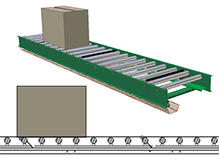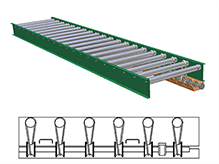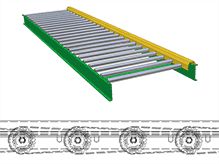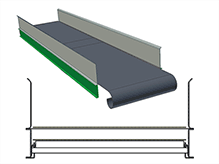Types of Powered Conveyors
Accumulation Conveyors
Accumulation conveyors are typically used in conjunction with other material handling conveyors and conveyor components. Warehouse automation utilizes accumulation conveyor in many conveyor handling systems as a way to manage product within the supply chain. Accumulation conveyors utilize pop-up sensor rollers located in "zones." These zones use a pressurized air system to hold the product in a queue until it receives a signal to release it to the next stage of operations. This can include moving products one at a time onto a weigh station, case sealer, sort system, palletizer, pallet handling or any other work station along the supply chain.
There are several types of common accumulation conveyor, however two of these handling systems are more common than the others. Zero pressure accumulation conveyor eliminates package collisions on the conveyor line by leaving gaps between each individual box, while minimum pressure accumulation conveyor places the individual boxes next to each other with little back pressure. Both are used in various industries in warehouse automation to handle a wide variety of products.
Also for consideration, SJF can supply specialty conveyor solutions as well. These include but are not limited to flexible chain, chain driven live roller, low voltage conveyors, flexible conveyors and vertical lifts. SJF can supply heavy duty pallet handling and spiral conveyors as well as specialty material handling systems such as food grade conveyors made of stainless steel. SJF is a systems integration provider of material handling equipment and software management systems for all of North America.
Accumulation conveyor is one of the most vital flexible solutions in any large industrial conveyor system. Without it, your warehouse control systems packaging machine, scale or other automated machines and handling equipment will quickly become overloaded and will not function properly.

Belt Driven Conveyor
Belt driven live roller conveyor consists of load rollers, a drive belt, return rollers and an external motor. The load rollers make up the surface on which product is transported. The rollers move using a belt that is located underneath the load rollers, which provides friction directly on the rollers and creates forward movement. The return rollers are used to keep the belt in place under the conveyor as well as to maintain tension on the belt at all times.
Belt driven live roller conveyor can be used in accumulation, induction and merge systems where product sizes and weights tend to vary. It provides limited capabilities for inclined movement or packages of differing shapes.
Belt Conveyor (aka: Belt On or Over Roller Conveyor)
With belt conveyor, the conveyor belt can be either sliderbed supported or supported by return rollers located underneath the load rollers. Belted conveyor is a fairly common type of powered conveyor and is what many people think of when they envision powered conveyor. Belted conveyor is very useful for transporting light and medium weight loads between locations.
In addition to being a good general purpose powered conveyor, belt over roller is also a desired solution for inclines or declines. Powered belt conveyors provide much control over the orientation and placement of loads, which can be good for bulky, irregularly shaped products. Because product orientation is easily controlled with belt over roller, it also makes a good customized conveyor to use in warehouse execution, production lines and sortation systems design.
Lineshaft Conveyors
Lineshaft conveyor can be used for both transporting and accumulating products. Lineshaft makes use of a drive shaft which runs the length of the underside of the conveyor and drives the load rollers individually using belts. Since the rollers are individually powered, lineshaft conveyor can easily be used for accumulation operations where there is a minimum amount of back-pressure on the product being transported.
The driveshaft is powered by a motor. Some configurations of lineshaft conveyor allow the conveyor to run both forward or backward, depending on the situation desired. Because there are fewer moving parts, today's lineshaft conveyor is typically quieter than most traditional conveyors. The belts also assist in reducing noise by holding the rollers firmly in place inside the frames which results in less rattling.
Chain Driven Live Roller Conveyors
Chain driven conveyors (sometimes referred to as pallet conveyors or pallet conveyor systems) are typically used to transport heavy loads at controlled speeds. Chains drive sprockets on the load rollers which, in turn, drives a chain and the sprocket on the next roller and so on. These systems transmit the same amount of power to each roller, thus insuring a smooth, even ride. These conveyors are very powerful and so are often found in foundries, manufacturing plants or other environments where a rugged conveyor solution is needed.
Chain driven conveyor offers several customized conveyor advantages that other types of conveyor systems designs typically do not or cannot offer. For instance, because there is no belt(s), chain driven conveyor provides the ideal custom solution for transporting both hot and cold loads that could damage other conveyor types. Chain driven conveyor can also resist contamination by grease and other particulate matter better than other handling conveyors. Chain driven pallet handling using chain conveyors are better able to tolerate uneven pallet bottoms or drums.
Trash Conveying Systems - Overhead Conveyors
Trash conveyor systems and regular sliderbed conveyor are two very similar products with one important difference - trash conveyor has guard rails attached to the sides of its frame to prevent materials from falling off the conveyor belt into the work area. Return rollers keep tension on the conveyor belt keeping it taut.
Overhead conveyors like trash conveyors are used mainly to transport empty boxes, paper trash and other light-weight refuse to a disposal area, compactor or incinerator while keeping it out of the way of production areas. It can help to create a better organized work area that will allow employees to perform their work efficiently and without hindrance. Since trash conveyor utilizes a sliderbed design, there are few moving parts to create noise. The sliderbed design of trash conveyor also makes it great for transporting materials overhead or on inclines and declines.
Slider Bed Conveyor
Slider bed conveyor and trash conveyor are very similar products, but regular sliderbed conveyor does not usually have guard rails. Many capacities of sliderbed are available, but lighter weights are more common.
Slider bed conveyor uses return rollers to run a conveyor belt along a smooth bed, allowing for the smooth transportation of many different load types. If the load is something that can roll easily, it's best to place it on a skid, pallet or even in a box.
Slider bed conveyor can easily carry loose components and other materials that roller conveyor has a harder time transporting. Since slider bed conveyor has few moving parts, it does not create much noise. The slider bed conveyor design also makes it useful in conveyor automation for transporting loads on inclines and declines. Typical slider bed conveyor automation applications include inspection, transportation and assembly lines operations.
Please call (320) 485-4974 (direct sales line), (800) 598-5532 (toll-free) or Email Us for pricing, availability and lead times. If you don't see what you're looking for, our sales specialists can often find it.








